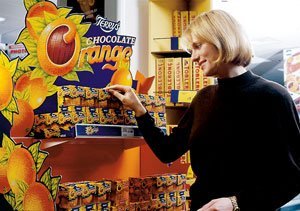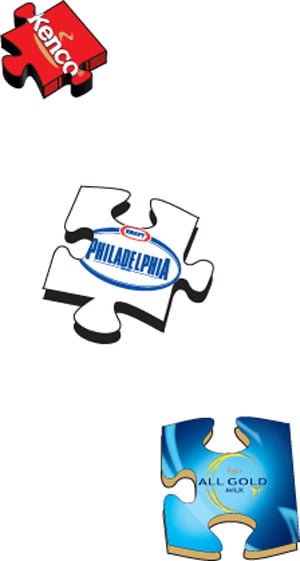
As consumers, we expect our favourite brands to be available wherever we want to buy them and to be of the highest quality. For example, we expect fruit, vegetables and dairy products to be fresh and appetising and we want confectionery to be attractively packaged and clearly labelled. Most people, however, are unaware of all the activities that are involved in bringing these products to us.
This case study looks at how a major food company has built a Customer Service Excellence Programme to ensure that its products are in the right place, at the right time, in the right quantity, in excellent condition and at the lowest possible supply chain cost.
Kraft Foods is the world’s second largest food company with an annual turnover in 1999 of some £18.7 Billion and UK sales in excess of £550m. Kraft Foods’ vision is to be recognised as ‘The Undisputed Global Food Leader” This means that its brands must be “First Choice” to its consumers and Kraft Foods must be seen as an ‘Indispensable Partner’ to its customers. Across the world, Kraft Foods business strategies include:
Accelerating The Growth Of Its Power Brands

In the modern global economy a Power Brand is a brand which delivers a competitive advantage based around three key areas; quality, value and trust. The four key Power Brands in Kraft Foods’ UK business are, The Kenco Coffee Company, Philadelphia, Dairylea and Terry’s Chocolate Orange.
Driving For Improved Quality And Service At The Lowest Effective Cost
The Kraft Foods Supply Chain function is challenged with providing excellent operational support which helps to deliver continued Power Brand growth.
This is reflected in the Supply Chain goal of ‘exceeding customer expectations in quality of product and service at lowest effective cost’. This is the basis for their ‘Golden Triangle’ model.
Service Exellece Program
To help in consistently delivering against its objectives, Kraft Foods has developed a model known as the Service Excellence Programme which creates a strong supply chain relationship between the company, as the supplier and its customers, the retailers.
The programme interlinks a series of proven, simple concepts that drive customer service up and cost out from the joint Supply Chain.
The Service Excellence Program Jigsaw
Kraft Foods has developed a jigsaw model to represent its Service Excellence Programme pictorially.
The 9 component pieces establish a framework around which Kraft Foods and its Supply Chain partners can build, implement and evaluate projects with the aim of improving day to day operational efficiency.
Each component piece captures the processes, activity and behaviour that will deliver service excellence.
Service Excellence Programme ´piece by piece´
Perfect ordering

Focuses on the successful management of a customer order from the moment it is compiled at the customer, its processing through Kraft Foods’s order systems to the point of delivery at the customer warehouse. Any ‘waste’ that could cause delay or disruption should be eliminated. The order should be compiled correctly using accurate data, sent at agreed timings with jointly agreed delivery windows. Ideally, the order is electronically communicated using EDI or the Internet.
Knowledge exchange
Involves a complete understanding of the joint Supply Chain including business systems and processes operating between Supply Chain Partners. This can be delivered in many ways, from a simple one day induction for the customer at the supplier premises or longer term assignments, e.g. job swaps. The overall aim should be to build a comprehensive shared knowledge base of systems, people and processes.
Increasingly e-commerce is improving communication with the use of e-mail and extranets making contact and the sharing of knowledge and information faster and easier.
Seasonal planning
Good Seasonal Planning ensures the supply chain operates smoothly through events such as:
- annual celebrations – Christmas, Mother’s Day, etc
- seasons – spring, summer, autumn and winter
- special events – World Cup, Olympics, Millennium, etc.
Demand from consumers will fluctuate dramatically during seasonal periods. The supply chain will need to react accordingly and flexible plans and processes are critical for success.
Seasons challenge the supply chain to deal with an increased volume of product in a very short space of time. Planning for a season will include the sharing and learning from historical forecast information, agreeing purchase quantities, arranging delivery timings and ensuring identical product specification data is held on Kraft Foods’ and its customers’ databases.
Delivery interface
Involves the fast and efficient transfer of products from the supplier to the customer. To move stock efficiently Kraft Foods and its Customers need to understand each other’s distribution operations. At Kraft Foods, sufficient resources need to be in place to compile the order on time and reflect specific customer requirements; for example, goods delivered on pallets may not exceed certain heights.
The order needs to be despatched on time and in the correct type of vehicle. Delivery of the order will be required at the receiving depot at the agreed time. Should errors or discrepancies arise there should be agreed processes which deal with claims or complaints.
Great people
Kraft Foods believes that a truly excellent Supply Chain relationship with its Customers cannot be achieved without great people who are professional, trustworthy, helpful and responsive to customer needs. Kraft Foods defines great people as those with a passion for customer service and with the skills and behaviour required to build a Supply Chain partnership. This is why it is the central piece of the jigsaw.
Kraft Foods’ employees need to listen, observe and act only when they have understood all the information. They should maintain a positive outlook in difficult situations and apply their knowledge in a supportive and constructive way.
Optimal inventory
Having enough stock (or inventory) of a product to satisfy customer demand, whilst not holding excess stocks sitting idle and getting old, is the goal of optimal inventory.
To optimise the inventory levels in the total supply chain, trading partners need to collaborate fully to understand the volume and type of inventory held along the chain and the future demands, to ensure production of a product takes place at the right time and is available for the customer and fresh for the consumer.
Stock may be held at manufacturing plants, warehouses or at the retailers’ stores. Information on stock levels and sales can be shared using new technologies like the Internet. The systems enable Kraft Foods and its Customers to view and act upon the same information at the same time creating a ‘total Visible Inventory Chain’.
Data alignment

For the supply chain to run efficiently, the supplier and the customer need to hold the same data about a product. This will include product description, number of units in a case, number of cases on a pallet, or bar codes and product information, such as detail on the product shelf life. Each area within the supply chain will use the information for a variety of purposes, for example the correct transmission of an order via Electronic Data Interchange (EDI) will require the use of the TUC code at the customer and Kraft Foods order management stages. At the customer depot, shelf life and product descriptor information will be checked.
Regular cross checks will ensure compatibility of data. Increasingly technology aids the process through use of extranets. Looking to the future, electronic ‘catalogues’ of information viewed on the internet and accessible by the supplier and customer will make this process easier and more efficient.
Variant management
There are times when products change, such as promotional product (e.g. a chocolate bar marked with a reduced price), new products into the marketplace or the jointly agreed substitution of one product for another.
Variant management is about successfully managing product change without affecting service. It is fundamental that Kraft Foods and its customers fully understand and have in place a process to manage:
- changes to new product specifications
- different order quantities and delivery timings
- changes in demand expected from the consumer.
Consumer satisfaction
At the end of the supply chain is the consumer, like you. It is key to Kraft Foods and its Customers that the consumer is 100 per cent satisfied with their purchase. This can, in part, be achieved by delivering a high quality product in perfect condition every time. If this does not happen it is essential that it is resolved efficiently and speedily to the consumer’s satisfaction.
The Consumer Satisfaction ‘piece’ defines the ideal complaint management process, specifically:
- How Kraft Foods and its Customers should handle consumer complaints.
- The mechanism for resolving the Supply Chain problem which caused the complaint.
- A crisis management policy for recall of product which may have a quality issue.
- A feedback route for consumer comments and suggestions e.g. a link to the Kenco Freephone Coffee Advice line.
Benifits Of The Service Exellence Program

Through implementing these programmes with its customers, Kraft Foods has been able to substantially improve the quality of service through:
- Improved understanding of the total supply chain.
- More efficient order and delivery processes.
- Better management of change such as promotions.
- Skilled people focused on the right things.
Additionally, through delivering operational excellence, cost savings along the supply chain have been realised. The model provides a simple template for good business practice that can be used in most supply chains.
Conclusion
In the modern business world, Consumers and Customers are rarely satisfied with anything less than ‘The best’. For a company like Kraft Foods to provide the best brands of coffee, chocolate, cheese and many other products, it needs to make sure that every part of its Supply Chain is working at its best.
The process that Kraft Foods has designed to ensure it delivers that service excellence to its Customers and Consumers is called The Service Excellence Programme.
This case study provides the student with an excellent example of what businesses need to do in today’s marketplace to ensure that consumers receive the products they desire in the right place, at the right time and in the right condition, every time.
